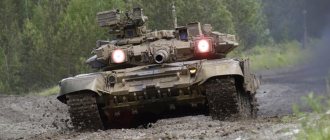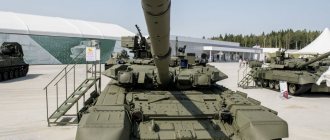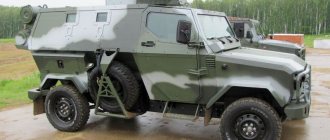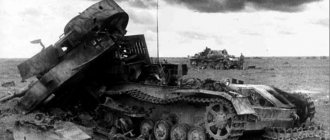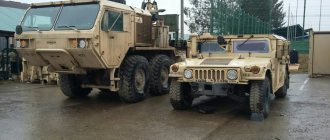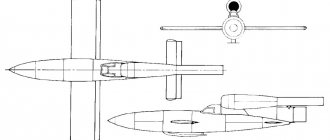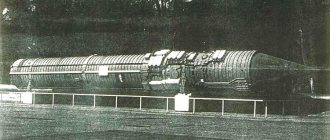Missile system R-36M "Satan"
• Missile system R-36M , code RS-20A, according to the classification of the US Department of Defense and NATO - SS-18 Mod.1,2,3 Satan (" Satan ") - a third-generation strategic missile system, with a heavy two-stage liquid, ampulized intercontinental ballistic missile for placement in a silo launcher of increased security type.
• A missile system with a multi-purpose heavy-class intercontinental missile is designed to destroy all types of targets protected by modern missile defense systems in any combat conditions, including multiple nuclear impacts in a positional area. Its use makes it possible to implement a strategy of a guaranteed retaliatory strike.
Main features of the complex : - launcher: stationary, silo; — rocket: two-stage with a liquid-propellant rocket engine using high-boiling fuel components, with a mortar launch from a transport and launch container; — rocket control system: autonomous, inertial, based on an on-board digital computer; — the missile allows the use of various types of combat equipment (warheads), including multiple warheads with individual guidance.
Main technical characteristics of the R-36M : Weight - 211 tons; Diameter - 3 m; Length - 34.6 m; Throwing weight - 7300 kg; Number of steps - 2; Rocket launch is cold; Firing range - 11200...16000 km; Accuracy (QUO) - 200 m. Conceptual diagrams of the rocket and control system were developed based on the possibility of using three variants of the warhead : - light monoblock with a charge of 8 Mt; — heavy monoblock with a charge capacity of 25 Mt; — separable from 8 warheads with a capacity of 1 Mt.
• Adopted into service on December 30, 1975.
• The Americans give our missiles their own names, which, admittedly, very figuratively characterize their combat capabilities. In particular, the Americans called the SS-18 missile in question “Satan,” clearly imagining its “supernatural” capabilities that cannot be “tamed” with the help of missile defense.
• After 10 thousand kilometers, it will safely deliver 10 individually targetable nuclear warheads. One blow and Washington, or even the entire District of Columbia, will no longer be on the world map. “Satan” is equipped with a system for overcoming NMD, its shaft is protected from a direct hit from a nuclear charge. “Satan” will definitely take off and reach the target, even if it comes under the influence of an electromagnetic pulse that knocks out any electronics.
Nuclear giant
The Russian Strategic Missile Forces are ready to simultaneously launch several dozen R-36M missiles.
Dungeon of “Satan”/ Photo: © AP Photo
Each is equipped with ten multiple warheads with individual targeting and can throw a thermonuclear charge with a yield of five to eight megatons into enemy territory.
In addition to real warheads, Satan carries many decoy heavy and light units that misinform enemy missile defense systems when the warheads approach targets.
Only such a powerful carrier as Satan is capable of lifting a load weighing almost nine tons and delivering it over a distance of more than ten thousand kilometers. This will not work with the solid-fuel rockets of the Topol and Yars mobile ground complexes.
It is not surprising that when concluding the Treaty on the Reduction of Offensive Arms (START-1), the United States placed emphasis on reducing the number of heavy silo-based liquid missiles.
By that time, the USSR arsenal contained more than three hundred Satan-type missiles. The agreement required that exactly half be destroyed.
Rocket
The delivery vehicle for the warhead, in which nuclear charges are located, is an intercontinental two-stage missile, the reach of which has an area of 300 thousand square kilometers. It is able to overcome the boundaries of highly effective and advanced missile defense systems and hit ten different targets with multiple components with a total yield of eight megatons of TNT. It is almost impossible to neutralize its effect after launch, which is why it received such a sonorous name - “Satan”. The missile complex is equipped with a thousand objects simulating nuclear warheads. Ten of them have a mass close to a real charge, the rest are made of metallized plastic and take the form of warheads, inflating in the stratospheric vacuum. No missile defense system can cope with so many targets.
How to launch a heavy rocket from a silo
The rocket body is made of aluminum and magnesium - rather soft metals. The wall thickness is 3 mm, otherwise the projectile will be too heavy. The rocket weighs more than 210 tons and must be launched from a deep shaft. It is easy to imagine what will happen if such a heavy and fragile object begins to be washed by hot gases escaping from the nozzles. Inside there are 195 tons of fuel, not just flammable, but explosive. But that's not all. At the head there are nuclear weapons with a yield of four hundred Hiroshima.
This is a technical challenge. And its Soviet engineers decided. The rocket is smoothly and carefully removed to the surface by three special powder charges, called pressure accumulators, raised tens of meters, and only after that the pre-prepared (“inflated”) launch stage engines are started.
This decision also made it possible to significantly increase the combat radius of the system. A large amount of fuel was consumed to initially overcome the force of gravity; in this case, its savings are approximately 9 tons.
This is just one example of the elegance of solutions, an illustration of the genius of the great Utkin. There are many of them; others would take a whole book to describe. Possibly multi-volume.
Exploitation
As of May 2006, the Strategic Missile Forces included: 74 silo launchers with R-36M UTTH and R-36M2 ICBMs, equipped with 10 warheads each. As of 2020, 46 R-36M2 Voevoda units were on combat duty.
in two position areas in Yasny (Orenburg Region) and Uzhur (Krasnoyarsk Territory) in a version with a multiple warhead with individual targeting units (10 warheads with a capacity of 1 Mt each), which are planned to remain on combat duty until the early 2020s.
List of Strategic Missile Forces formations that have either operated or are operating the RS-20:
- 31st Rocket Army in Orenburg 13th Red Banner Orenburg Rocket Division in Yasny (Dombarovsky)
- 59th Missile Division in Lokomotivny (Kartaly) - disbanded in 2005
- 62nd Red Banner Missile Division in the village. Solnechny (Uzhur-4)
Peaceful use
The Dnepr conversion program, developed in the 1990s at the initiative of the presidents of Russia and Ukraine, provides for the use of decommissioned RS-20 ICBMs for spacecraft launches. The first launch under the Dnepr program was carried out by the combat crew of the Strategic Missile Forces on April 21, 1999, while the British scientific and experimental satellite UoSAT-12 was successfully launched into the intended orbit. Also, the Dnepr launch vehicle can be used to perform cluster launches of spacecraft, for example, on July 29, 2009 at 22:46 Moscow time, a cluster launch of 6 satellites into orbit was carried out at once (DubaiSat-1, Deimos-1, UK-DMC 2 , Nanosat 1B, AprizeSat 3, AprizeSat 4) for the UAE, Spain, USA and UK). The rocket used in this launch was manufactured in 1984 and was on combat duty for 24 years. All vehicles were launched into target orbits and transferred to the control companies of the launch customers. Thus, along with the launch of satellites into orbit, the tasks of extending the service life of combat missiles on combat duty are being solved in parallel.
In total, from 1999 to March 2020, 22 launches were carried out under the Dnepr program, of which 21 were successful, while 141 satellites and devices were launched in the interests of commercial customers. The operating company of the Dnepr conversion program is CJSC International Space.
Notes
- ↑
- ↑. MilitaryRussia.Ru - domestic military equipment (after 1945). Retrieved June 30, 2020.
- International Institute for Strategic Studies.
The Military Balance 2020 / James Hackett. - London: Taylor&Francis, 2020. - P. 189. - ISBN ISBN 9781857438352. - (English). Soviet Armed Forces 1945-1991
. Michael Holm's website. Retrieved February 18, 2013.
- (English). Soviet Armed Forces 1945-1991
. Michael Holm's website. Retrieved February 18, 2013.
- (English). Soviet Armed Forces 1945-1991
. Michael Holm's website. Retrieved February 18, 2013.
- (English). Soviet Armed Forces 1945-1991
. Michael Holm's website. Retrieved February 18, 2013.
- . yuzhnoye.com.ua. Retrieved August 29, 2020.
- (unavailable link). Retrieved June 15, 2012.
Design Features
- The R-36M is a two-stage missile using sequential stage separation. The fuel and oxidizer tanks are separated by a combined intermediate bottom. The onboard cable network and pipelines of the pneumohydraulic system, which are covered with a casing, run along the body. The 1st stage engine has 4 autonomous single-chamber liquid propellant engines, which have a turbopump fuel supply in a closed circuit; they are hinged at the rear of the stage on the frame. Deflection of the engines at the command of the control system allows you to control the flight of the rocket. The 2nd stage engine includes a single-chamber propulsion engine and a four-chamber steering rocket engine.
- All engines run on nitrogen tetroxide and UDMH. The R-36M implements many original technical solutions, for example, chemical pressurization of tanks, braking of the separated stage using the exhaust of boost gases, and the like. The R-36M is equipped with an inertial control system, which operates thanks to an on-board digital computer complex. Its use allows for high shooting accuracy.
- The designers provided for the possibility of launching the R-36M2 even after an enemy nuclear strike on the area where the missiles are located. "Satan" has a dark heat-protective coating that facilitates passage through the radiation dust cloud that appears after a nuclear explosion. Special sensors that measure gamma and neutron radiation during the passage of the nuclear “mushroom” register it and turn off the control system, but the engines continue to operate. After leaving the danger zone, the automation turns on the control system and corrects the flight path. ICBMs of this type had particularly powerful combat equipment. There were two variants of the warhead: MIRV IN with eight warheads (900kt each) and a monoblock thermonuclear one (24Mt). There was also a complex for overcoming missile defense systems.
Video about the Satan rocket
https://youtube.com/watch?v=nwFP_slb1g0
https://youtube.com/watch?v=nwFP_slb1g0
Author of the article:
Nikiforov Vladislav
Go underground
Until the 1960s, strategic missile weapons in the USSR were located at open launch complexes; the launch facilities were almost not camouflaged. But with the development of reconnaissance and surveillance systems, missiles and all technological equipment were literally “buried” in the ground.
The first silo complexes were intended for long-term storage of R-12U and R-14U missiles. Single-stage medium-range missile systems made it possible to send nuclear “parcels” two and four thousand kilometers, respectively.
The missile silo was a well 30 meters deep and about six meters in diameter. A starting table, supporting structures and ventilation systems were installed at the bottom to maintain constant temperature and humidity.
From above, everything was covered with a multi-ton concrete “lid”, the so-called protective device, which, if necessary, moved to the side along the rails. The missiles were stored in such a bunker for many years and were in constant combat readiness.
The silos were modernized and improved for each new type of missile, and their level of security increased.
For example, more modern underground launch pads for UR-100 ballistic missiles already had quick-opening hinge systems - before launch, the “lid” weighing more than a hundred tons was automatically folded back in 30 seconds.
The missiles were filled with fuel at the manufacturing plant and “packed” into special transport and launch containers, after which they were lowered into the silos. And they remained there until the end of their service life.
Scary nuclear train
It was not for nothing that the USSR was called a great railway power. Large distances prompted Tsarist Russia to build rail lines at an unprecedented pace; in the Soviet years, new lines were laid, covering the entire territory of our country with a network of tracks. Day and night, trains pass along them, among which it is never possible to distinguish those under the roofs of whose carriages many mega-deaths lurk. The Satan mobile complex could be based on a railway platform disguised as an ordinary train, which the most advanced reconnaissance satellite would not be able to distinguish from an ordinary one. Of course, the weight of the launcher of 130 tons did not allow the use of simple rolling stock, so in addition to technical problems, transport problems also had to be solved, and on an all-Union scale. Wooden sleepers were replaced with reinforced concrete ones, the quality and strength of the fabric were brought to the highest level, because any accident could instantly turn into a disaster. The Satan missile launcher is 23 meters long, just the size of a refrigerator car, but the head fairing had to be developed in a special way - a folding design. There were other problems, but the result justified the costs. A retaliatory strike could be delivered from an unpredictable point, which means it was guaranteed and inevitable.
There is no alternative
Since the conclusion of the Strategic Arms Reduction Treaty (START), Russia has destroyed hundreds of heavy missile silos. They were flooded with water, filled with concrete, and the missiles themselves were disposed of.
Currently, the Strategic Missile Forces are armed with about 50 R-36M Voevoda missiles and several dozen UR-100 missiles. In addition, in the arsenal of rocket scientists there are silo modifications of the light Topol-M.
In recent years, the Strategic Missile Forces have relied on mobile or, as they are also called, ground systems - the Yars PGRK. It is believed that mobility ensures high survivability - missile systems are camouflaged and constantly moving, and, thanks to their high maneuverability, they can do without roads.
But there is also the other side of the coin - if a reinforced concrete stationary mine can be disabled only by a direct hit from heavy penetrating ammunition, then even a small sabotage group with grenade launchers can destroy a mobile complex.
Or, for example, a powerful anti-tank mine planted along the route. Therefore, each complex includes specialized combat vehicles and security personnel who accompany the installations everywhere. As the capabilities of sabotage groups expand, these machines are improved.
However, no one is going to completely abandon stationary buried launchers - along with the PGRK, missile formations are also receiving silo versions of the Yars. In addition, in the coming years, the Voevoda’s successor, the new generation heavy complex RS-28 Sarmat, will take up combat duty.

